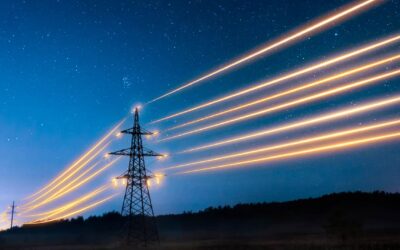Achieve superior speed and scale using AI combined with GIS
Data matters. But quality matters more.
In the middle of an unprecedented green energy transformation, utilities must meet daunting regulatory, environmental, and operational challenges that come with increased demand around the world and particularly in the U.S. This has caused many companies to digitally transform, initiating enterprise implementations that automate and digitize previously manual and paper-based work.The result is a deluge of information, lacking accuracy and completeness. Indeed, location and attribute differences between different datasets often require correction. Conflation tools can merge data from multiple sources to fix inconsistencies. However, this is costly, time-consuming, and labor-intensive.
However, a new paradigm exists with the rise of AI, coupled with more powerful geospatial solutions. Location-based automated conflation has transformed how utilities and other asset-intensive companies manage and correct their data. Using powerful location analytics and machine learning techniques, companies can improve the accuracy and completeness of data at a massive scale and in a fraction of the time. They improve their ability to make better decisions that meet current and future demands on sustainability, reliability, performance, and more.
Lots of data. Little accuracy.
Many utilities today face a data accuracy problem. For years, the amount of data collected by utilities through multiple methods—including field surveys, aerial imagery, and CAD drawings—has outpaced the systems used to manage and maintain that data. Companies had more data than they could process because their software and systems couldn’t process it fast enough. This included not enough automation capabilities or human resources.
The unused and inaccurate data impacted operations and business performance. Digital transformation initiatives, including real-time analytics and reporting, suffer because data becomes a limiting factor.
In addition, organizations can’t use modern network utility models because data isn’t spatially accurate enough. Maximizing these new geospatial capabilities is limited without massive amounts of quality data.
Moreover, safety is impacted as well. For example, utilities may have a lot of remote sensing imagery, which helps for multiple use cases, like understanding where dead wood sits or vegetation encroachment exists. However, they can’t pinpoint high-risk assets compared to high-risk environmental concerns if they don’t have accurate pole, line, and station locations to overlay with vegetation data. If poles and lines aren’t correct, vegetation management strategies suffer. This impacts the utility, customers, the community, and the climate.
In another example, when engineers assess equipment on poles, they are given pole locations. Still, they often spend several minutes or even hours validating and correcting data. At the same time, they are in the field performing work orders—because it’s only then they discover a data discrepancy between the reported and actual locations.
Making data spatially or geographically accurate saves companies time and money because they won’t have to rectify inaccurate locational data while performing tasks. They won’t perform assessments, like high-risk vegetation analysis, using low-quality data. And they can take advantage of modern capabilities—like network modeling and real-time reporting—because they’ll have timely, complete, and accurate data. Automated conflation, which involves using remotely sensed information or other data already owned in-house to make maps more precise, then joining that map data with other data sets, can help in this effort.
Automated conflation explained
A popular use for automated conflation involves identifying and merging source data that needs improvement in its geographic accuracy. It must be combined with an accurate target data set derived from a high-fidelity source. The challenge involves finding the precise target locations, such as pole locations, within the source data to merge with other datasets and associated attributes, such as pole heights or associated pole equipment. Organizations can create accurate location data by having field crews perform GPS surveys to capture location data, but it is time-consuming and costly.
Companies can use high-resolution aerial imagery, remote sensing, or ortho mosaics from drones to generate their target source–but they have to find objects (e.g., discrete and unambiguous utility pole locations) within the imagery they can match; that’s typically a manual process that involves sending staff in the field to find objects represented in the data and measure their real-world locations in three dimensions.
This takes staff away from their usual high-value work to perform the mundane, time-consuming task of identifying the targets they want to use for correcting other location data. And because of finite resources, these surveys can only be done between significant projects when staff have downtime. Organizations can bring in contractors, but it’s costly.
Automating the generation of target data offers an excellent opportunity. Companies can combine geospatial technology and machine learning (ML) to use computer vision (CV) trained models that find objects to generate target locations.
Suppose aerial imagery has been generated and organized to less than a foot of accuracy. In that case, you can train ML models to identify pole locations or other assets to use as targets for location correction. Companies can automate that process and scale at a high level so they can generate target data at orders of magnitude faster than previous methods.
How much faster?
A manual process might involve identifying up to 300 to 400 locations daily, but with automated ML models, the process can accurately identify more than 100,000 locations daily.
AI-powered, GIS-fueled conflation
AI-enabled automated conflation, including geospatial capabilities, provides a high-powered process to gain location accuracy for utility asset data at a fraction of the time of manual processes.
No matter how large the service area is, companies of every size can dramatically improve data accuracy at every level and asset location. They can maximize imagery investments by using it as a reference for combining and rectifying data.
Location-based automated conflation solution uses custom-trained ML libraries and post-processing toolsets to reach incredible speeds and rates of accuracy. Using high-resolution imagery and pattern recognition, organizations can identify and prioritize data such as pole locations and recommend updates to source datasets using accurate target data at a fraction of the time of traditional methods.
ML processes automatically perform conflation—data joining and rectifying–to identify the highest accuracy possible. Organizations gain precise location and attribute values by merging datasets from multiple sources into one authoritative and enriched dataset.
Organizations with large amounts of geographically dispersed assets typically face the greatest challenge of inaccurate data due to the complexity inherent in maintaining massive amounts of data with disconnected locations.
Combined with ML, geospatial solutions help overcome this problem by finding the correct geography of assets and assigning that location to the related tabular attributes. GIS takes target locations, compares them to features in a database, and generates shift vectors to correct massive amounts of geospatial data.
For example, a precise location can be assigned to a pole, and all its related attributes—pole type, material, etc.—are given the correct geography. Related assets, such as lines of base data, can be merged and given a correct geography as well.
The result? Companies gain highly accurate and complete data at a fraction of the time, cost, and resources involved. This positively impacts safety and operational efficiencies. Decision makers have better data to manage networks. They can also perform regulatory requirements better with accurate data that improves audit results and reporting.
An AI/ML leader you can trust
Locana, a TRC Company, helps utilities across the U.S. and around the world with their automated conflation needs. Locana has built proprietary processes and tools leveraging the Esri deep learning toolset and safe soft FME, as well as industry-standard geospatial tools used to develop models, tools, and scripts to automate these processes. Locana can use high-resolution imagery, video, lidar, terrestrial photos, and other formats to detect location accuracy.
Locana consultants, technologists, developers, and industry experts bring in-depth knowledge and skills built on decades of experience. As a TRC company, Locana has the additional investment and engineering expertise, including everything from AMI 2.0 to ADMS to OMS, to unlock value in data companies already have.
In addition to deep technology and industry knowledge, Locana provides its clients with world-class consulting, including agile methodologies, scrum, and other client-first project management techniques. These practices deliver lower acquisition and total ownership costs and ensure on-time, on-budget, and on-target project delivery.
With Locana as your trusted GIS partner, you gain:
- Deep energy industry knowledge and experience working with clients
- Technical IT/OT, geospatial, and AI expertise
- A proven track record of delivering self-sustaining, self-sufficient projects
- Commitment to transparency, communication, and ownership
- Solutions, packages, and patterns that accelerate time-to-value
***
Visit today to learn more about the solutions we offer to help you improve data accuracy and completeness.


